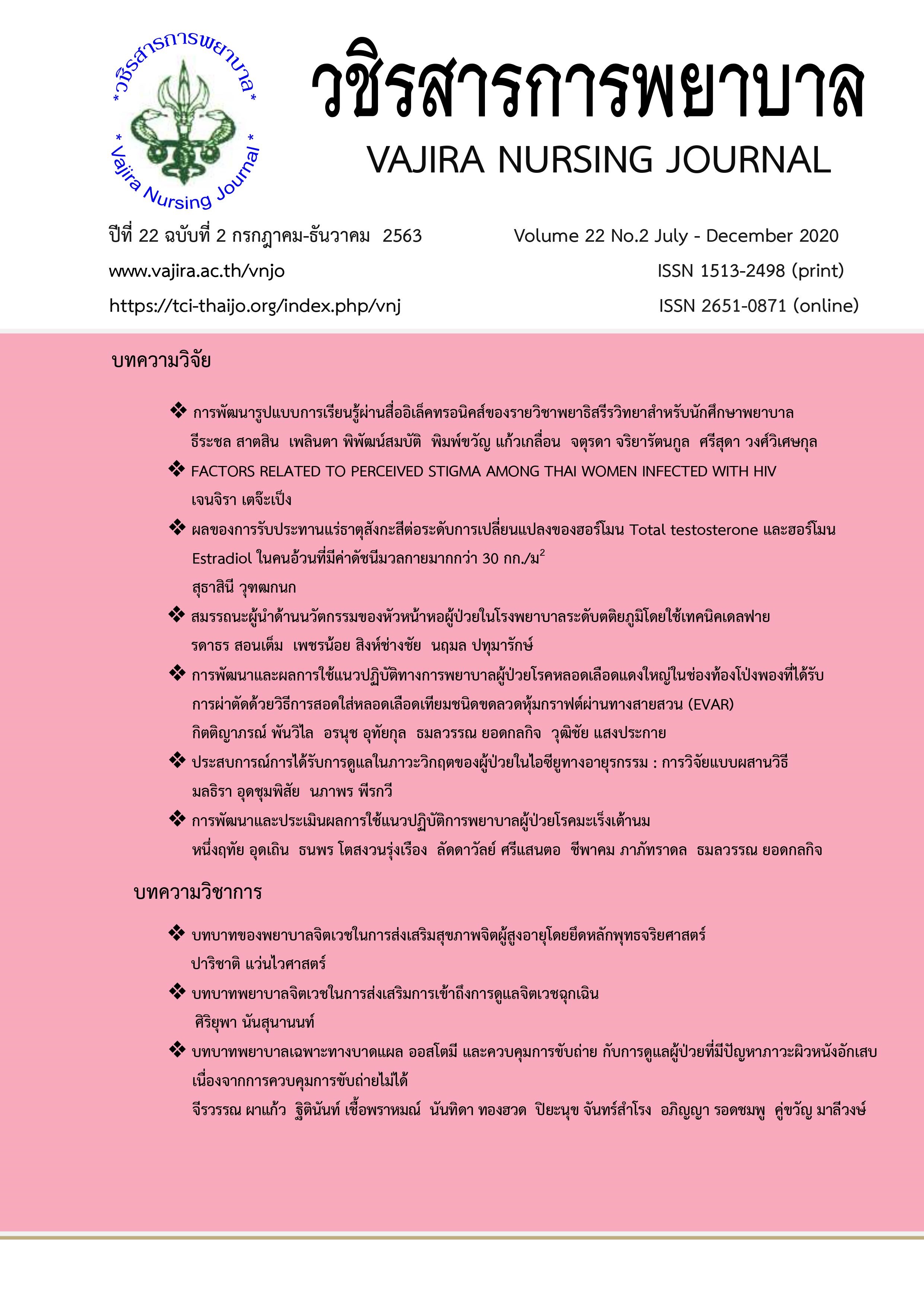การพัฒนารูปแบบการเรียนรู้ผ่านสื่ออิเล็คทรอนิคส์ของรายวิชาพยาธิสรีรวิทยา สำหรับนักศึกษาพยาบาล
Main Article Content
บทคัดย่อ
การวิจัยในครั้งนี้ มีวัตถุประสงค์เพื่อศึกษาการพัฒนารูปแบบการเรียนรู้ผ่านสื่ออิเล็คทรอนิคส์ของรายวิชาพยาธิสรีรวิทยาสำหรับนักศึกษาพยาบาล เป็นการวิจัยกึ่งทดลอง กลุ่มตัวอย่างคือ นักศึกษาพยาบาลชั้นปีที่ 2 (รหัส 59) ที่ลงทะเบียนรายวิชาพยาธิสรีรวิทยา รหัสวิชา 6012607 คณะพยาบาลศาสตร์ มหาวิทยาลัยสวนดุสิต จำนวน 84 คนเครื่องมือที่ใช้ในการเก็บรวบรวมข้อมูลประกอบด้วย 1) ข้อมูลพื้นฐานส่วนบุคคล 2) แบบการสอบย่อยหลังการเรียนการสอนเสร็จสิ้น 1 สัปดาห์ผ่านระบบอิเล็กทรอนิกส์ จำนวน 18 หน่วยการเรียน วิเคราะห์ข้อมูลโดยการหาค่าร้อยละ ค่าเฉลี่ย ส่วนเบี่ยงเบนมาตรฐาน และค่าสถิติ
Paired-sample t-test
ผลการวิจัยพบว่าค่าเฉลี่ยของคะแนนเฉลี่ยโดยรวมหลังการศึกษาสูงกว่าการบรรยายทั่วไป ก่อนการพัฒนารูปแบบการเรียนรู้ อย่างมีนัยสำคัญทางสถิติที่ระดับ <0.05
Article Details
เนื้อหาและข้อมูลในบทความที่ลงตีพิมพ์ในวชิรสารการพยาบาลถือเป็นข้อคิดเห็นและความรับผิดชอบของผู้เขียนบทความโดยตรง ซึ่งกองบรรณาธิการไม่จำเป็นต้องเห็นด้วย หรือร่วมรับผิดชอบใด ๆ ทั้งสิ้น
บทความ ข้อมูล เนื้อหา รูปภาพ ฯลฯ ที่ได้รับการตีพิมพ์ในวชิรสารการพยาบาล ถือเป็นลิขสิทธิ์ของวชิรสารการพยาบาล หากบุคคลใดหรือหน่วยงานใดต้องการนำทั้งหมดหรือส่วนหนึ่งส่วนใดไปเผยแพร่ต่อหรือเพื่อกระทำการใด ๆ จะต้องได้รับอนุญาตเป็นลายลักอักษรจากวชิรสารการพยาบาลก่อนเท่านั้น
เอกสารอ้างอิง
ภัทรนิษฐ์ สุรโกมลเศรษฐ์ และมาลี กาบมาลา. (2557). การแสวงหาและการใช้สารสนเทศของผู้ปฏิบัติการพยาบาลขั้นสูง. สารวิจัย มข. มส. (บส), 2(2), 35-45.
วีณา จีระแพทย์. (2544). สารสนเทศทางการพยาบาลและทางสุขภาพ. คณะพยาบาลศาสตร์ จุฬาลงกรณ์มหาวิทยาลัย.
อรรคเดช สุนทรพงศ์. (2559). ศึกษาการพัฒนาสื่อการเรียนรู้ด้วยตนเองผ่านทางสื่ออิเล็กทรอนิกส์ของรายวิชาออกแบบเครื่องเรือนและการประมาณราคา รหัสวิชา 554341. วารสารชุมชนวิจัย, 10(1), 20-28.
อลงกรณ์ ศรีสวัสดิ์ และลัดดา ศิลาน้อย. (2553). การศึกษาผลสัมฤทธิ์ทางการเรียนด้วยบทเรียน E-Learning เรื่องการศึกษากับการสร้างคุณลักษณะเพื่อการอนุรักษ์สิ่งแวดล้อมสำหรับนักศึกษาระดับปริญญาตรี ชั้นปีที่ 2 สาขาสังคมศึกษา คณะศึกษาศาสตร์ มหาวิทยาลัยขอนแก่น. วารสารศึกษาศาสตร์ มหาวิทยาลัยขอนแก่น, 33(4), 147-151.
อัมราภัสร์ อรรถชัยวัจน์, ธีรพร สถิรอังกูร, นันทรัตน์ ศรีนุ่นวิเชียร และจุฑารัตน์ เพ็ญเขตต์วิทย์. (2556). แนวทางการจัดระบบสารสนเทศทางการพยาบาลในโรงพยาบาล. นนทบุรี : สำนักการพยาบาล สำนักงานปลัดกระทรวง กระทรวงสาธารณสุข.
Benner, P., Sutphen, M., Leonard, V., & Day, L. . (2010). Educating Nurses: A Call for Radical Transformation. CJNR, 42(2), 141-143.
Cook, P. R. . (2011). Critical thinking in the health professions. In In M. J. Bradshaw & A. J. Lowenstein (Eds.) (Ed.), Innovative teaching strategies in nursing and related health professions (5th ed., pp. 49-63). Sudbury, MA: Jones & Bartlett Publishers. .
Nantasenee S, Wongwisesku S, Sukcharoen P, & Techangkul L. (2018). Development of Learning and Teaching Process for Nursing Students at SuandusitUniversity. Boromarajonani College of Nursing, Uttaradit Journal, 10(2), 166-179.
Pipatsombat P, Kienwong T, Kwhanyuen R, Chobarunsitti C, Tejangkura L, & Satsin T. (2020). The Effectiveness among Nursing Students of the Comprehensive OSCE Clinical Skills in the Achievement of Adult and Elderly Nursing Practicum 2. Boromarajonani College of Nursing, Uttaradit Journal, 12(1), 59-75.
Potgieter, E. (2012). Clinical teaching: developing critical thinking in student nurses. Prof Nurs Today, 16(2), 4-8.
Sarakshetrin A, Songwatthanayuth P, & Panawatthanapisit S. (2019). Learning Strategy in Nursing Education toward The Developmentof The Twenty-First Century Learning Skills. Journal of The Royal Thai Army Nurses, 20(3), 18-26.


